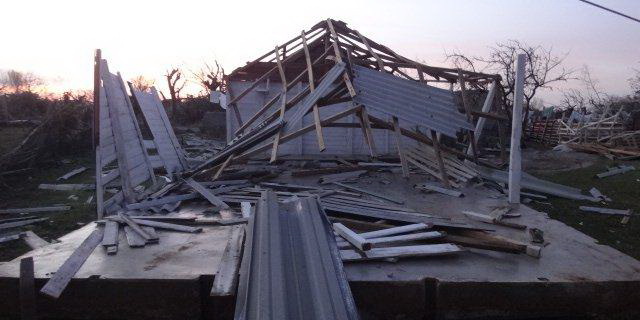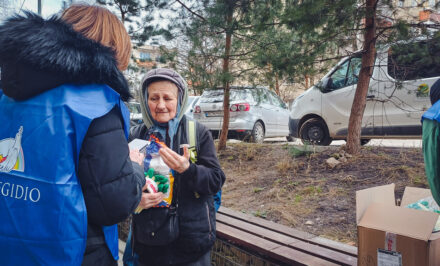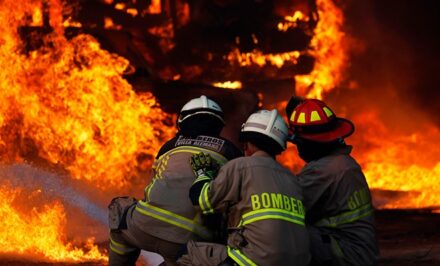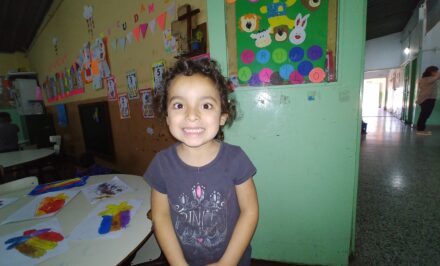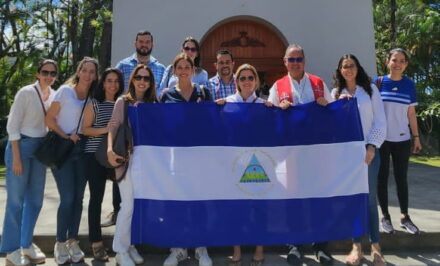CUBA, Bishop Wilfredo Pino Estévez •
Fr. Roland Montes, a Schoenstatt Priest from the Diocese of Guantánamo-Baracoa, is currently studying in Rome and collaborates with schoenstatt.org. He sent us a report from his bishop about his visit to the parishes most affected by Hurricane Matthew. There were no deaths, thus, the media ignores the damages suffered in Cuba, where entire cities were destroyed and the people need food, water, clothes, everything. However, faith is not lacking…

I truly do not know how to begin to describe what I experienced during those days. It is true that we have difficult images etched in our minds, but also, we must be grateful to the many people who are concerned and busy, those who were praying and pray for us, and those who have promised help or have already sent it.
My memory returns to the 15 August, Feast of Our Lady of Assumption of Baracoa…Who would imagine that fifty days after we saw those beautiful fireworks that closed the 505th Anniversary of Cuba’s first city celebration, a Category 4 hurricane, who everyone repeatedly called “powerful” would fill the city (and several municipalities) with debris and leave almost every house without a roof!
The damage was truly great. Many palm and coconut trees lost all their leaves. Looking at the mountains, they seem like white cigarettes standing on end. The other trees are only trunks and branches because they are stripped bare. And what damage the houses received! In the cities of Baracoa, Maisí and Imías many of the houses are without roofs and many more are completely destroyed. All this horror was experienced during the night of 4 October. Listening to the testimonies of people, I thought about the Morning Prayer hymn that begins with the verse: “The night, the chaos, the terror…” That is what many of our brothers/sisters experienced.
Reaching out to people
Since I received the news about the tremendous damage, I thanked God because there were no deaths, because seeing what happened, there could have been quite a number of deaths. Thank God, all the people were evacuated in time, or they sought refuge in caves or in those known as “ground rods” (they told me that in one of them there were thirty-two refugees.) Some did not leave their houses thinking that they would withstand and fortunately, they were not mistaken. What was clear is that those houses that withstood the fury had plaster roofs. I was glad to see that the new Seventh Day Adventists’ church on the highway to Sabana remained intact. Until recently, it was a wooden building with a light roof, but now it is built of blocks with a concrete roof. They stayed there during the hurricane and several dozen people were saved.
The morning after Matthew passed, at exactly 5:45 a.m., Chebita (a missionary in Imías), Mario, the chauffer, and I left for the affected communities. Upon arriving at the place known as Bate-Bate (a road along the sea), we saw that the highway was destroyed, and the storm surge had thrown mounds of sand and rocks of different sizes onto the road that hindered traffic. When we tired of removing rocks so the car could pass, we tried to take a nearby embankment…and we got stuck. It took three hours to get out. Three men who passed on a moped helped us. We will never forget their gesture, because they were soaked with rain and they got muddy. May God reward them! Then we were able to continue to visit the communities of San Antonio, Imías y Cajobabo to share with priests, religious and lay people. In Cajobabo, someone told us that seventy-five people had spent the hurricane in a stucco house. Here the first tears were shed: a lady that I know, cried along with her granddaughter. They had lost the roof and their “four” little things. The reality dawned as we approached Baracoa, there the damage was greater.
If the force of a category 4 hurricane is enormous, it would be enough to show a photo of an enormous ceiba beside the highway, since the hurricane could not pull it from it roots because the tree resisted, then it cut it in half! We could also show the state of the hill of La Farola: yesterday we counted twenty-one landslides that were still not cleaned, so I suppose there must have been approximately thirty, which is the same as one per kilometer. Or how about the zinc shingle that impaled an orange tree in Baracoa at Deacon Carreño’s house (now without a roof.) Of course, it reminded one of the historic photo of that palm tree (in Batabanó) that was impaled by a fragile pine board during the 20 October 1926 hurricane…
Arriving at Baracoa
We arrived at Baracoa because God placed his hand along with other hands of solidarity. Upon going up La Farola, there were many rocks on the road. We removed them by hand, and that is how the car was able to make progress. There was another automobile behind us with authorities from the province and the country. Together we had the same objective: to arrive at Baracoa. A little ahead, there was a work group waiting for the authorities with chainsaws, etc. They began to open the road. We got at the end of the caravan. This how we progressed until we almost reached Baracoa. An enormous collapse made it impossible to continue. But they came from Baracoa to get the authorities, and they invited me, if I wanted to, to pass through the collapse on foot and then to go to the city in one of the jeeps that came. Since my objective was to reach Baracoa even by foot, I did not hesitate for an instant.
Thanks to this gesture, I was able to reach Baracoa. Upon entering the city, I began to see the damage. Our church of Cabacú, dedicated to the Virgin of Carmen was on the ground. Only the back wall remained standing. I was finally able to enter the Baracoa parish house at 1:30 a.m., almost twenty hours after leaving Guantánamo for Baracoa.
The following morning, seeing the destruction, I tried to encourage myself by repeating what the faithful respond at every Mass when the celebrant says: “Lift up your hearts,” and they respond, “We lift them up to the Lord.” My deepest desire was to– lift my heart to God to then have the strength to help the victims also to raise their hearts.
More than other times, and before the frustration of feeling impotent and not being able to fix everything that was damaged, I turned to intercessory prayer. The episode of Moses interceding with arms raised on high, while the people got the better of the fight (Ex. 17) came to mind. When Moses lowered his arms (I say, when he stopped praying), the people began “to lose the battle.” That is why Moses’ helpers looked for stones to place under his elbows so he could keep his arms raised. That is what I asked of those I encountered: for them to help in all they can, but not to forget the great power of intercessory prayer.
To Maisí, Fr. Rolando’s parish
Knowing the damages “on the surface” in the cities of San Antonio, Imías and Baracoa, only Maisí was lacking. I finally arrived at this city yesterday. I had tried twice, but the two highways were impassable: one by a broken bridge, and the other one were full of trees, and fallen electric poles (there were more than 1,000 according to the newspaper). I imagined that I would surely find the worst because according to my poor calculations the right side of the hurricane passed through there (which they say is the strongest). That is what I found. I do not think I exaggerate when I affirm that Maisí is destroyed. There are pictures of collapsed houses that remind us of the photos we saw of the earthquake in Haiti.
We were able to visit Sabana, La Máquina, La Yagruma and Punta de Maisí. Everything was so destroyed and so many trees had disappeared that it looked like places we had never been. Its aspect was so changed!
The newspaper, Venceremos [We will conquer], reported 80% of the houses were affected.
We tried to lift the people’s spirits. To hear about their experiences and their gratitude to God for being alive “which is the most important, because material things can be fixed.” As always, I learned many things from simple people. Without getting down from the car, I chatted with a family that we did not have anything to give, only our ears and our encouragement. When we were leaving, the father of the family asked us: “ To come again.”
Pilgrim Church and a bishop returning again and again
This is what our Church is doing. Coming back again and again. Locating people, who are vulnerable because of their illness, their disabilities, or their old age to give a little encouragement, a little food: some soup, rice, or some cookies with guava.
What optimism the Cubans have! I commented that the taro plants had lost their leaves and were destroyed. A woman from there added: “Now the taros will surely come back prettier”…
In circumstances like those experienced, the same as in the hospitals: sorrow unites. People had more solidarity. They told me that during the hurricane, Protestants and Catholics, sheltered in the same place, had prayed together for the first time in this town. The same thing happened with people who had been distant from each other.
A lady also told us that while the hurricane was striking, “We praised the Lord, we sang and prayed so that we would live even if everything was destroyed.”
There were deeds that also “raised” my soul:
Finding priests and religious visiting people…
The example of a motorcyclist carrying a passenger. Upon arriving, the passenger removed his helmet and was going to give ten pesos to the motorcyclist. The motorcycle owner declined to take it; he did not want to take advantage of another’s misfortune!
To see several caravans of trucks from the electric and telephone companies, who came to help their brothers/sisters of the Guantánamera Province, on the highway with the Cuban flag in front.
To hear the leader of a crew of electricians, who when I passed and greeted him, he asked: “Bishop, pray for us, we are working with electricity.”
As we were on the Jamal road, to hear a woman shout, who only said one word that became an order for us: “Help us!”
Be with the people where they are
After talking with the priests and the superiors of the religious from Baracoa, I asked them to undertake several tasks during those first days:
Be with the people where they are. Gather their tears. Lift their hearts. Give them hope. Do and say what the apostles said: “I have no silver and gold, but I give you what I have…” (Acts: 3:6).
Give food to the hungry. In fact, yesterday, we picked up a man who was walking on the highway in search of his relatives, and he told us that he had not eaten in two days and had slept one day…Fortunately the Caritas-Guantánamo, and their director Maribel, are very active at this point.
The community helpers should make a list of the people who need this help. On its part, the diocesan truck is moving from one side to the other taking what other dioceses sent: cookies, rice, beans, water, sausages, sardines, oil, ham, detergent, candles, matches, etc.
Invite everyone to pray, like Moses did, interceding for our people (Ex. 17). Many initiatives can emerge in that respect. The family rosary to the Our Lady, Consoler of the Afflicted could accompany these days.
Continue celebrating Sunday Mass, especially in places where the church has collapsed. I recommended they remove the debris and place a table that will serve as a temporary altar and invite the faithful to bring their umbrellas in case it rains or there is sun. We must be clear, and everyone should know that the church building was destroyed…but not the Church! I personally celebrated the first Sunday Mass in the Basilica of Baracoa, and the other two over the debris of the churches of Cabcú (Baracoa) and Punta de Maisí (close to Faro).
Give all that you can
During those first days, many people and institutions came who wanted to help with our recuperation. Youths from the Cathedral and from La Milagrosa, along with Frs. Jean, Heidel, Yaser and several lay people have gone to the affected places to give their help. The youths from Bayamo have promised their immediate presence. In La Milagrosa, the Claretian Sisters cooked pots of rice with ham since very early and united with the Dominicans of the Holy Rosary and Chebita, they distributed to those affected in Imías. Caritas from the different dioceses is sending donations. The Catholic organisms of help have also responded. Telephone calls come from everywhere in the country and the rest of the world offering their help. There is a great deal of mail, and I am not able to answer it all yet. The people are so good! I know that many people including my relatives, called once and again to try to communicate with me, but in the two days I was in Baracoa there was no communication. I extend my personal gratitude to everyone.
I pray for the priests from Vicaría de Baracoa-Maisí (Matteo, José, Efrén and Alberto), for the religious (Sr. Judith, Sr. Louise, and Sr. Dayanis, and Deacon Carreño and his family). I pray for so many lay people who are working wonders. I know they are the right hand of the Lord, who wants to touch, console and to help all the victims. May God give them strength and health so they can continue to do what we have read at some time: “Do all the good you can. By all the means you can. In all the ways you can. In all the places you can. At all the times you can. To all the people you can. As long as ever you can.”
A Good Friday was experienced; faith convinces us that there will be an Easter Sunday. This is the guiding thread of a vertebral column that has to sustain us at these moments.
Fortunately, Christians are lucky that thanks to our faith, we see double, or we see everything the world sees, but we also see what no one sees. Moreover, it is like the good thief, crucified close to Jesus: in the midst of tragedy, he found the road. We have to find God’s salvation in this moment where tragedy is imposed on us, or we can fall into the temptation of not seeing it.
Photo on top: Parish Church of Maisí after the storm
Original: Spanish. Translation: Celina M. Garza, San Antonio, TX USA´. Edited: Melissa Peña-Janknegt, Elgin, TX USA


